Best Ways & Tips for Carrying Binoculars On a Hiking Trip
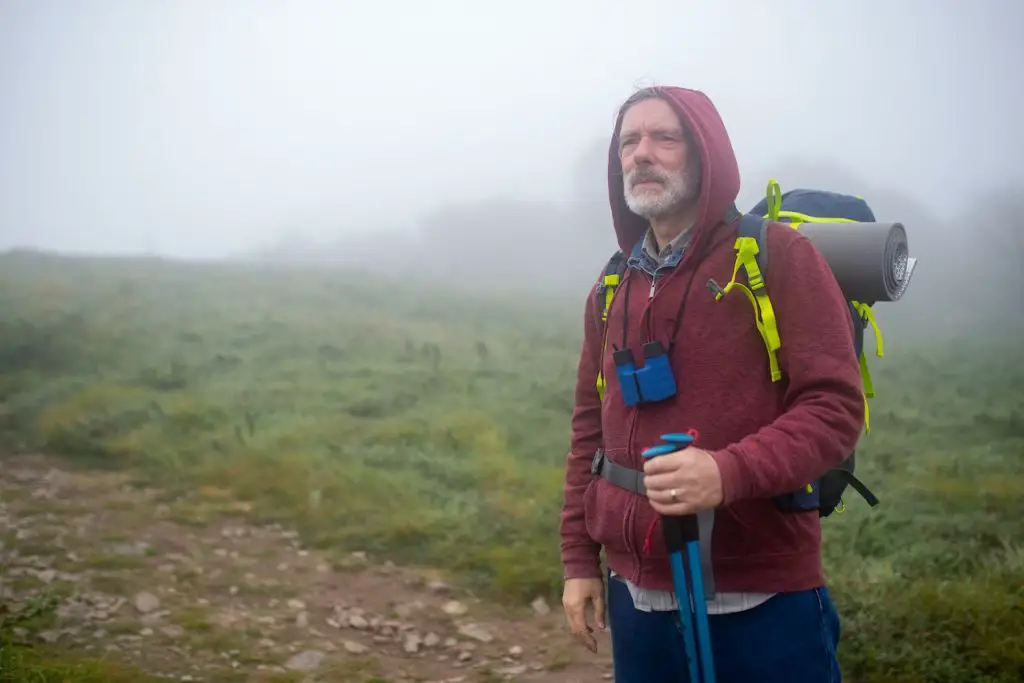
While treading the winding trails of majestic mountains, one cannot help but be captivated by the awe-inspiring scenes that imprint a positive impact on the mind.
However, with the aid of binoculars especially for hiking your experience takes on a whole new dimension of wonder.
Yet, as fragile outdoor equipment, binoculars demand careful handling during hiking adventures.
A simple misstep in their carrying can lead to trouble, than can kill the thrill of exploration.
In this blog post, we aim to provide you with the best instructions to ensure a seamless and rewarding experience of carrying binoculars on your hiking trips.
Let’s see what is the best way to carry it based on two popular methods i.e harness or straps
Binocular Harness vs. Bungee Straps:
Deciding on the best method for carrying your binoculars can be a bit confusing.
Let me clear up the confusion for you.
I will discuss the two most common methods of carrying binoculars and analyze what is best suitable for you.
1st Method-Binocular Bungee Straps
Binocular bungee straps, also known as chest straps, offer a simple and affordable solution for carrying binoculars on a hike.
They typically cost between $35 to $50 and come in various designs from different manufacturers.
Here are the key characteristics of binocular bungee straps:
Easy Attachment:
Bungee straps are adjustable and can be easily clipped onto the binoculars, providing a secure fit around the chest.
Compact and Lightweight:
Bungee straps have a smaller profile, making them easy to carry and less bulky when not in use.
Convenient for Scouting:
For scouting and short hiking trips, bungee straps are a popular choice due to their quick and hassle-free setup.
Peripherals and Layering:
Bungee straps sit lower on the chest, offering better peripheral downward vision, especially useful when scouting or hunting from a tree stand. However, they may impede vision if wearing multiple layers.
Limited Gear Storage:
Bungee straps generally do not provide additional storage options for extra gear items like wind puffs, range finders, or chapstick.
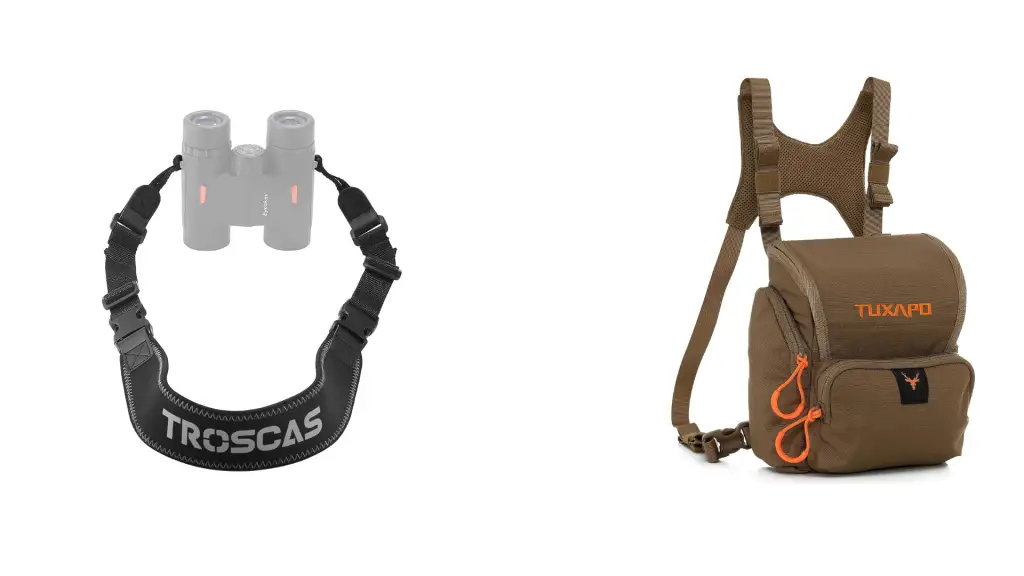
Binocular Harnesses
Binocular harnesses are another option for carrying binoculars during hikes.
They often come with a higher price tag, but they offer unique advantages that may make them more suitable for some users. Here are the key features of binocular harnesses:
Extra Gear Storage:
Many binocular harnesses come with extra pockets or compartments that allow you to carry additional gear items like range finders or wind puffs.
Secure and Stable:
Binocular harnesses hold binoculars higher on the chest, providing a more secure and stable fit, especially during rigorous activities.
Better for Layering:
Harnesses can accommodate layering better than bungee straps, making them ideal for cold weather conditions.
Ease of On and Off:
For hunters who frequently add or remove layers, binocular harnesses may be a more practical choice due to their ease of use when putting on or taking off.
Compatibility and Adjustability:
Some harnesses are specifically designed for particular binocular models, ensuring a snug fit, while others offer adjustable straps to accommodate various binocular sizes.
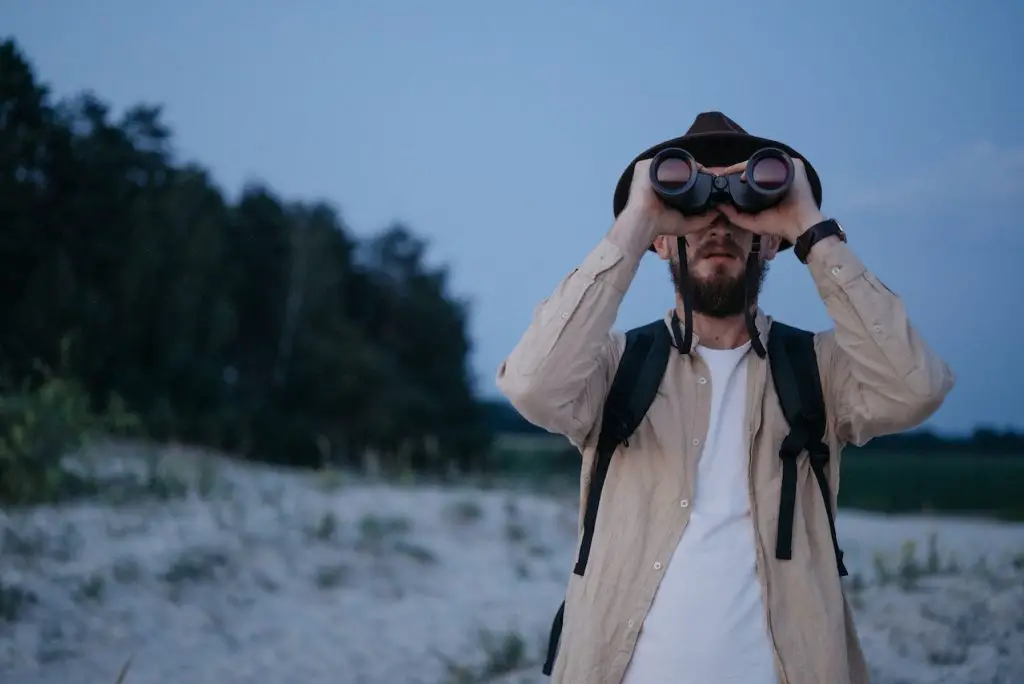
Choosing the Right Option for You: Strap Or Harness
If you value quick and easy setup, and you primarily engage in scouting or short hikes, bungee straps may be the better choice for you.
On the other hand, if you require additional gear storage, prioritize stability and layering, or engage in more extended and intense hikes, a binocular harness might be the more suitable option.
I have a Rick Young Bino Harness, that I can definitely recommend to my readers as I have found them to be a winning choice for hikers like me.
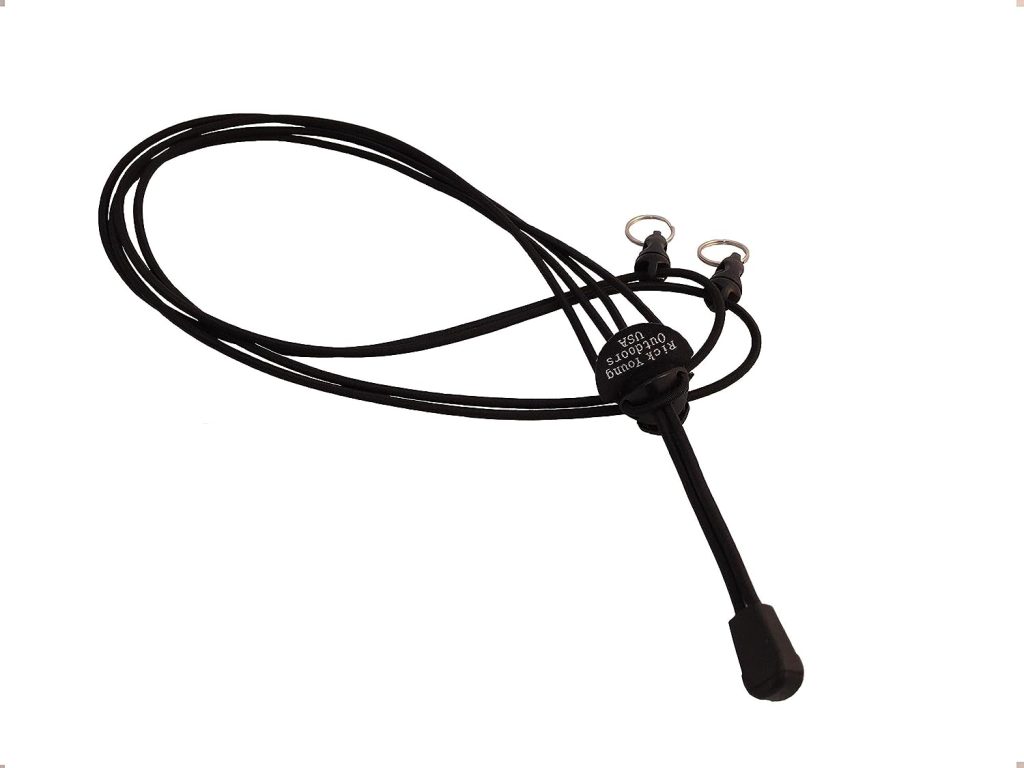
Its innovative use of bungee cord ensures a secure and snug fit around the binoculars, making it easy to carry during walks.
Moreover, its lightweight design ensures minimal burden and a quiet journey through the wilderness.
Even when unexpected raindrops begin to fall, the harness comes to the rescue, allowing for easy attachment of eye covers to protect the lenses.
Also Read: Should You Use A Binoculars Case
Binoculars Backpack Placement On A Hike
While hiking how you carry your backpack and where you place your binoculars within it can greatly impact your comfort, convenience, and overall hiking experience.
Securing Binoculars Within the Backpack
While binocular straps and harnesses are excellent for keeping your binoculars readily accessible during the hike, there are times when you may need to store them in your backpack, such as during adverse weather or challenging terrain.
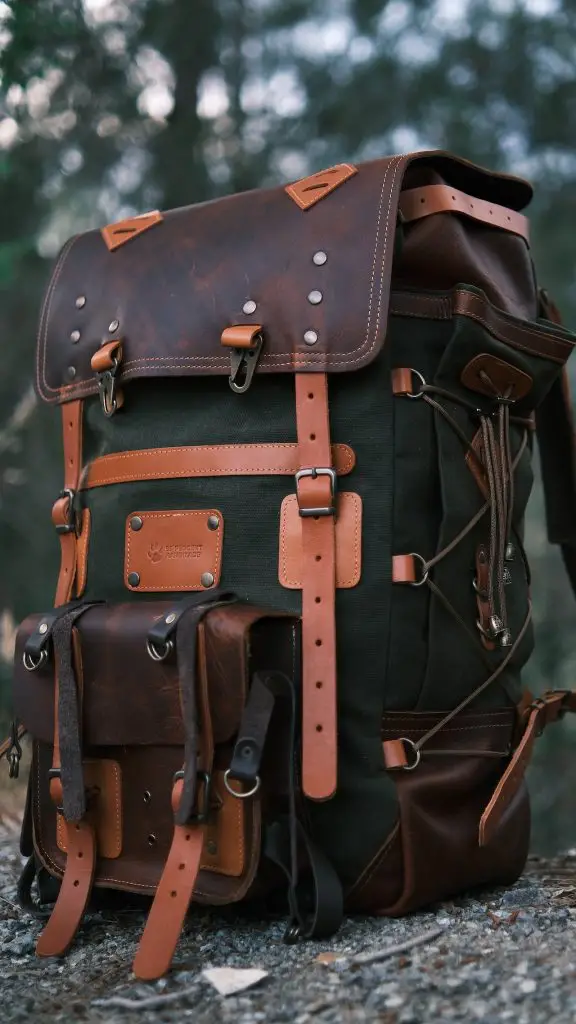
Use a Dedicated Compartment or Pocket:
Many backpacks come equipped with specialized compartments or pockets for safely storing small, delicate items like binoculars. Utilize these spaces to prevent the binoculars from moving around or getting damaged during the hike.
Add Protective Padding:
If your backpack lacks dedicated compartments, consider adding protective padding around the binoculars to prevent any impacts or scratches. Use soft materials such as microfiber cloths or foam to cushion the binoculars.
Wrap Binoculars in Clothing or a Soft Cloth:
Another option is to wrap the binoculars in clothing or a soft cloth before placing them in the main compartment of the backpack. This provides additional protection and keeps them secure.
Remember that the positioning of your binoculars within the backpack should not hinder your access to other essential items or make your backpack overly cumbersome.
Organize your gear strategically, ensuring that items you may need frequently, like snacks or a water bottle, are easily reachable without having to unpack everything.
Tips for Enhancing Your Hiking Experience with Binoculars
Hiking with a pair of binoculars in tow opens up a whole new world of exploration and discovery.
Whether you’re a seasoned birder, a nature enthusiast, or simply enjoy capturing stunning landscapes, binoculars can greatly enhance your outdoor experience.
Identifying Wildlife and Birds
- Be Patient and Observant: When using binoculars for wildlife observation, patience and keen observation are key. Scan your surroundings slowly and thoroughly, looking for movement, flashes of color, or any signs of animals or birds.
- Learn Calls and Behavior: Familiarize yourself with the calls and behaviors of common wildlife and birds in the area you’re exploring. This knowledge will help you identify species more accurately, even if they are partially hidden.
- Use a Field Guide: Carry a field guide or use a bird identification app to aid in recognizing different bird species. A field guide provides valuable information on bird plumage, behavior, and habitat, making identification easier.
- Adjust Your Focus: Practice adjusting the focus of your binoculars quickly and accurately. This skill is essential when identifying fast-moving or distant wildlife.
- Be Respectful of Wildlife: Keep a safe and respectful distance from wildlife to avoid disturbing them. Remember that binoculars allow you to observe from afar without getting too close.
Observing Scenic Landscapes
- Panoramic Scans: Use binoculars to take in the panoramic views of landscapes. Scan the horizon and explore distant mountain ranges, valleys, and bodies of water.
- Spot Unique Features: Binoculars can help you spot unique geological formations, waterfalls, or other points of interest that might otherwise go unnoticed.
- Enhance Your Viewing Experience: Look for binoculars with a wide field of view to capture more of the scenery in one glance. A wider field of view allows you to immerse yourself fully in the grandeur of nature.
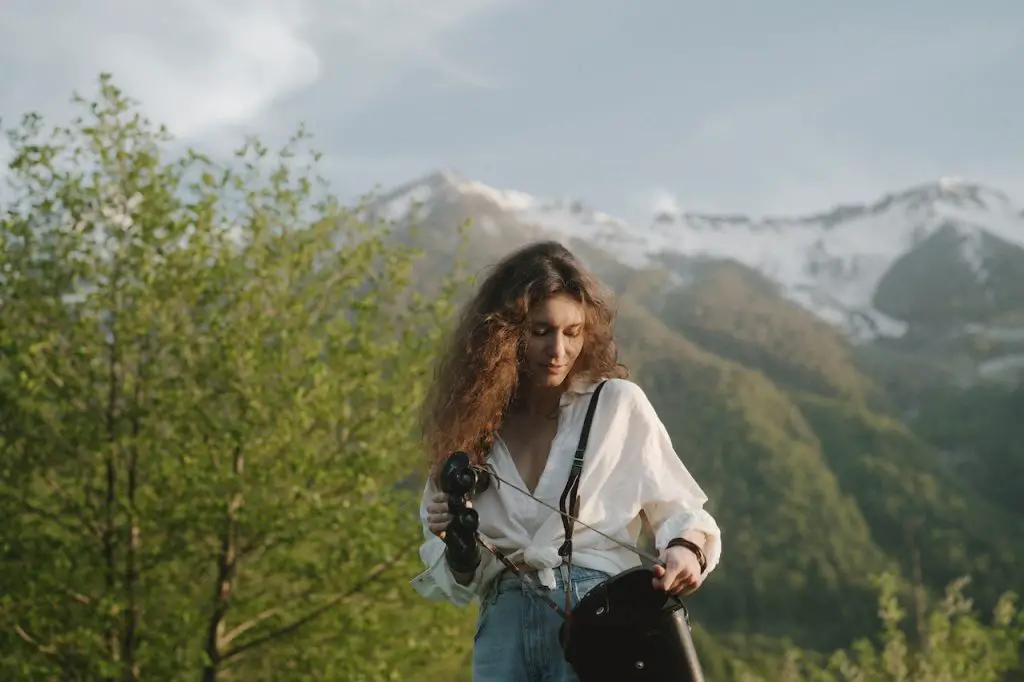
Choosing the Right Binoculars for Hiking
Not all binoculars are suitable for hiking, as the weight, size, and features can impact your comfort and overall enjoyment.
Here, we will explore the factors to consider when selecting hiking binoculars and delve into the key differences between compact and full-sized binoculars, as well as the importance of waterproof and fog-proof features.
Factors to Consider When Selecting Hiking Binoculars
Weight and Size:
One of the most critical factors to consider when choosing binoculars for hiking is their weight and size.
Since you’ll be carrying them for extended periods, opt for lightweight models that won’t strain your neck or shoulders.
Compact binoculars are often the preferred choice for hiking due to their portability and easy handling.
Magnification and Objective Lens Diameter:
The magnification power and objective lens diameter play a crucial role in determining the performance of binoculars.
A higher magnification allows you to see distant objects more clearly, but it may result in a narrower field of view and shakier images, especially when handheld.
For hiking, a moderate magnification of 8x or 10x is generally recommended. The objective lens diameter influences the amount of light entering the binoculars, affecting their low-light performance.
While larger lenses offer better visibility in dim conditions, they can make the binoculars bulkier and heavier.
Field of View:
The field of view refers to the width of the area you can see through the binoculars at a specific distance.
A wider field of view allows you to scan the surroundings more easily and locate moving objects quickly. For hiking, a wider field of view is advantageous, especially when observing wildlife in action.
However, it may slightly compromise image clarity at the edges.
Compact vs. Full-sized Binoculars
When choosing hiking binoculars, you’ll encounter two main categories: compact and full-sized binoculars. Each has its own set of advantages and trade-offs.
Compact Binoculars:
- Lightweight and portable, making them ideal for extended hikes
- Easy to handle and fit in pockets or small compartments of a backpack
- Generally have a smaller objective lens diameter, which may affect low-light performance
- Suitable for casual wildlife observation and general outdoor activities
Full-sized Binoculars:
- Larger objective lens diameter, providing better light-gathering capabilities for improved low-light performance
- Generally offer a wider field of view and more comfortable viewing experience
- May be heavier and bulkier, which could be a concern for long-distance hiking
- Preferred by serious wildlife enthusiasts and those who prioritize image quality over portability
Waterproof and Fog-proof Features
When exploring the outdoors, unpredictable weather conditions are inevitable. To protect your investment and ensure lasting performance, consider binoculars with waterproof and fog-proof features.
Waterproofing:
- Waterproof binoculars are sealed with O-rings to prevent water from entering the optical system. This feature is crucial for hikes in rainy or wet environments, where moisture can damage the lenses and compromise the clarity of the view.
Fog-proofing:
- Fog-proof binoculars are purged with inert gases, such as nitrogen or argon, to prevent internal fogging in changing temperatures or humid conditions. This feature ensures that the lenses remain clear and the view remains crisp even in challenging weather.
Conclusion
Carrying binoculars on hiking trips can significantly elevate your experience in the wilderness.
The ability to view the breathtaking landscapes up close and spot wildlife with clarity enhances the joy of exploration.
However, it is essential to handle these delicate optical devices with care to avoid any mishaps that could dampen the adventure.
By following the best ways and tips we have shared in this blog post, you can ensure the safety and convenience of carrying binoculars while hiking.
Whether you choose a binocular harness or bungee strap, prioritize comfort and stability to fully immerse yourself in the magic of nature’s magnificence.
